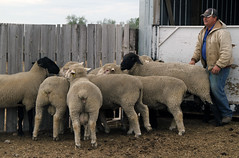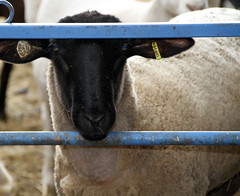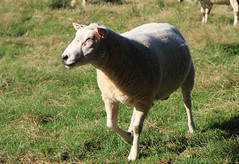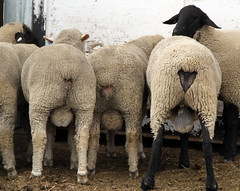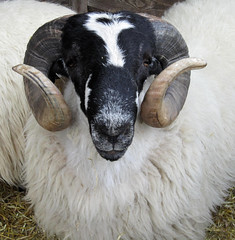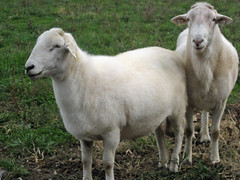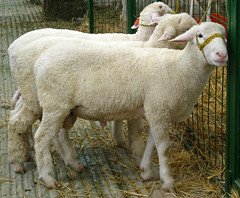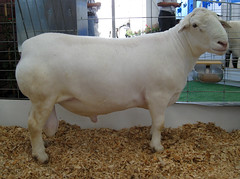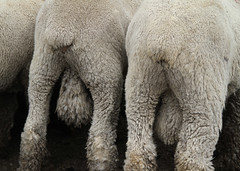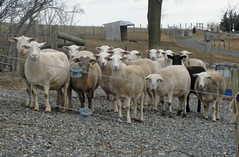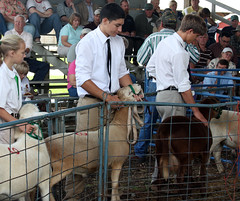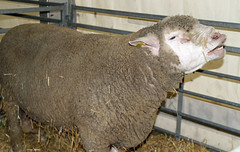- Sheep 201 Index
- Other web sites
Reproduction in the ram
The ram is the most important member of the flock, yet often the most neglected. Not only does he contribute most of the genetics to the flock, but his success as a breeder will go a long way towards ensuring a profitable lamb crop.
Puberty
Puberty is the age at which the ram's reproductive organs become functional, his secondary sex characteristics develop, and he is ready to successfully mate ewes. Most ram lambs reach puberty between 5 and 7 months of age at approximately 50 to 60 percent of their mature weight.The onset of puberty is affected by breed, genetics, and nutrition. Ram lambs on a low plane of nutrition may not reach puberty until they are 12 months of age or older. Some breeds reach puberty earlier than other breeds: prolific breeds and hair sheep. Meat breed rams tend to reach puberty earlier than wool breeds.
Spermatogenesis
Sperm is the male reproductive cell. Sperm production takes about 49 days (7 weeks) in the ram. Sperm is produced in the ram's testicles. Research has shown that the bigger the testicles (scrotum size) the more sperm a ram produces. If the ram's testicles are too small, he may not produce enough sperm during the breeding season to maintain good fertilization rates. The epididymis stores and transports semen. -=A large, firm tail is indicative of good reserves whereas a small, soft tail would indicate the opposite.
Nutrition can have a dramatic effect on testicle size. Research has shown that improving nutritional intake during the two-month period before breeding can increase testicle size and subsequent sperm production up to 100 percent. At the same time, overfeeding can have a detrimental effect on sperm production.For normal sperm production to occur, the testes have to be at a temperature several degrees below normal body temperature. The ram has large sweat glands in the skin of the scrotum and a system of muscles that raise or lower the testes into the body for temperature regulation.
Percent motility % normal morphology White blood cells Brucella ovis Source: Sheep Production Handbook (2002) Seasonal Effects on Reproduction
Sheep native to temperate climates are usually quite seasonal in their breeding habits, though rams are less affected than ewes. A ram's testicular size, sperm production, and mating capacity will vary according to the season of the year, being highest during the normal fall breeding season.
Some breeds are much less seasonal in their breeding behavior: Dorset, Rambouillet, Merino, Polypay, Finnsheep, Romanov, and hair sheep. Temperature is also a seasonal component affecting fertility in the ram. As little as a half degree change in body temperature may reduce spermatogenesis and/or libido.
Mating
A ewe in heat (estrus) will generally seek out the ram. She will sniff and chase after him. The ram responds to urination by the estrus ewe by sniffing, extending the leg, and curling his lip. Curling the lip is called the "flehmen response." If the female is receptive, she will stand for mating. The ram may fail in several initial attempts to mount the ewe. He may repeatedly mate the same ewe. Rams will tend to select older ewes over younger ewes and sometimes will choose ewes of their own breed over ewes of another breed.Some producers prefer to use one ram per group of ewes. If more than one ram is used, the older ram(s) will usually dominate the younger ram(s) and may prevent the less dominant ram(s) from breeding. The rams may fight at the expense of mating ewes. It will be more difficult to detect infertile rams or male-oriented rams in multi-sire situations. In large flocks, multi-sire matings are usually necessary. On the other hand, single-sire matings run the risk of low conception rates or an extended lambing season if a ram with reduced fertility or libido is used.
Breeding Soundness Exam
Preparing a ram for breeding should start well in advance of the breeding season. You should never wait until the last minute to purchase or select rams or check their readiness for breeding. Rams should be purchased at least several months before the start of the breeding season.The purpose of a breeding soundness exam (BSE) is to evaluate a ram's potential breeding ability. While only a low percentage of rams are sterile, many rams have reduced fertility. Research has shown that 10 to 15 percent of rams that are given a BSE fail or have questionable fertility. A BSE should be conducted by a veterinarian or other trained individual.
The BSE consists of two parts: a physical examination and a semen evaluation. Rams should be evaluated for lameness, body condition, and any other physical defects which could interfere with the breeding process. Rams need to be free from footrot or foot scald, and if necessary have their hooves trimmed prior to being joined with ewes. The general health of the ram should be evaluated by observing his eyes, feet, legs, prepuce, and penis for any defects that could interfere with breeding.
The testes and epididimides should be palpated. A testicle that has scar tissue or is abnormally small will reduce the breeding capacity and endurance of the ram. Swelling of the epididymis could be an early indication of epididymitis (Brucella ovis).
Scrotal circumference
Scrotal circumference (width of the testicles at the widest point) should be measured as it gives a good indication of a ram's breeding ability. Sperm production is directly correlated (85%) to testicular width. Scrotal circumference will vary with season and body condition, but should be at its maximum peak during the fall breeding season.
Ram lambs with a scrotal circumference of less than 30 centimeters and adult rams with a scrotal circumference of less than 32 centimeters should probably not be used for breeding. There is some evidence to suggest that rams with larger testicles will sire more prolific ewes and that his offspring will reach puberty earlier. Increased scrotal circumferences have been associated with increased ejaculate volume and sperm motility in mature rams. The heritablity of scrotal circumference is estimated to be 35%.
Scrotal circumference (cm)
Ram lambs, 8-14 months
Mature rams, > 14 months
Source: Testing Rams for Breeding Soundness, 2017 While the above table can provide some general guidelines, it is important to understand that scrotal circumference can vary significantly by age, breed, and season. There is a correlation between scrotal circumference and body weight in all breeds. Differences of up to 30 percent have been observed in rams in spring and autumn. The table was developed for US range rams. Standards may be different for smaller breeds or breeds in other countries. For example, Swedish researchers recommended a minimum scrotal size of 26 and 28 cm, respectively for ram lamb and mature rams of the Gotland breed. In the UK, there are different standards for lowland vs. hilled breeds.
Semen samples can be collected using electro-ejaculation or via an artificial vagina. Usually veterinary assistance is required to collect semen. Semen should be evaluated for sperm motility, morphology, and white blood cells. The minimum acceptable standards are fair gross motility or 30 percent individual motility and 70 percent normal morphology. White blood cells in the semen are an indication of infection (e.g. epididymitis).
A BSE does not include an evaluation of a ram's sex drive or breeding behavior.
Libido (sex drive)
The willingness to breed ewes is highly variable among rams and can have a major impact on sheep production, especially in a single-sire mating scheme. Libido is a ram's desire to mate. It is regulated by the release of testosterone, produced by specialized cells in the testes.Some breeds of rams show libido almost continuously once they reach puberty. In other breeds, there is a marked decline in libido during the non-breeding season. Underfed and overfat rams may show reduced libido. A ram's desire to mate also decreases with age and disease conditions, such as arthritis.
Some rams have inheritantly poor libido. In fact, studies have shown that up to 15 percent (average of 8 to 10 percent) of rams are homosexual and will not mate with ewes. Unlike heterosexual males, male-oriented rams do not experience an LH surge when exposed to estrus ewes. They also have a reduced capacity for producing testosterone.
Animal scientists are hoping to develop a blood test which would identify rams that will not mate with ewes. There is some evidence to suggest that rearing rams in an all-male environment may have a detrimental effect on mating behavior.A "serving capacity test" can be conducted to determine a ram's desire to mate ewes. In a serving capacity test, rams are exposed to estrus ewes, and their breeding activity is recorded over a period of two weeks or more. Research has shown that a serving capacity test is useful for identifying low and high-performing rams.
Ram serving capacity may be affected in utero by number and sex of siblings. Rams born as co-twins were shown to have the highest serving capacity and single born rams the lowest. In another study, long-term selection for reproductive rate in ewes did not affect mating behavior in male offspring. However, serving capacity or breeding behavior is a heritable trait.The simplest way for a producer to evaluate mating behavior is by observing breeding performance as rams are exposed to ewes. The use of raddle paint (on the brisket) or a marking harness can be used to monitor breeding activity. The color of the paint or marking crayon should be changed every 17 days, starting with the lightest color first.
If a ram fails to mark ewes, he could lack the desire to mate and should be replaced. If a high percentage of ewes re-mark after the first 17 day heat cycle, this means the ram is mating the ewes but they are not becoming pregnant. When it's more than a few ewes, it is likely the result of a sub-fertile or sterile ram.
Ram Management
A ram may lose up to 15 percent of his body weight during the breeding season. Consequently, rams need to be in good body condition at the time of breeding (condition score 3 to 4). Thin rams (condition score 1 or 2) may have difficulty getting the ewes bred, while fat (condition score 5) rams may be too lazy to breed, and their fertility may be affected during periods of hot weather.
Rams should be sheared, treated for internal parasites (if necessary), have their feet trimmed, and be started on the diet that they will be consuming during breeding 2 to 4 weeks prior to breeding. They should be included in the flock vaccination program.Ram to Ewe Ratio
The number of ewes that a ram can breed in a 34 or 51-day breeding season varies according to the age and breeding experience of the ram, the terrain in which the ram is working, the size of the pasture, and the number of ewes that will be cycling at one time. A ram can usually mate 3 to 4 ewes per day.In general, the recommended ratio for mature rams is 1:35 to 1:50. In large flocks, the percentage of rams to ewes is often higher. Ratios of 1:100 or 1:150 are not uncommon. Even higher ratios have been reported in the literature for experienced mature rams mating mature ewes in small pastures. On the other hand, if estrus has been synchronized, more ram power is needed, generally one ram for every 5 to 10 ewes.
*higher under certain circumstances
Mature ram Ram lamb Synchronized matings Ram lambs
A ram lamb at 5 months of age will settle some ewes, but he will be a better breeder by the time he is 7 or 8 months of age. As a general rule of thumb, ram lambs should be 50 to 60 percent of their mature weight before being used for breeding. A well-grown ram lamb should be able to mate 15 to 30 ewes in a 34 day breeding season.
Ram lambs should be fed separately from mature rams. Ram lambs and mature rams should never be run together in the same breeding group. The older ram(s) will dominate dominate and may injure the younger ram(s). Ram lambs should be observed closely to monitor their breeding behavior and libido to ensure they are servicing and settling ewes.
The Ram Effect
Although recommendations vary, rams should be isolated from ewes for at least 6 weeks in order for the ram effect to work. Ewes must have no contact with rams by either sight, sound, or smell, which means that they must be separated by distance.
The "ram effect" is when non-cycling (anestrus) ewes are stimulated to ovulate by the sudden introduction of a fertile ram or "teaser" ram. Rams produce a chemical substance called a pheromone, the smell of which stimulates the onset of estrus. When ewes and rams are in constant contact (sight or smell), the pheromones are much less effective at inducing estrus.
Ewes that are not cycling when a ram (or teaser) is introduced will ovulate in 3 to 4 days. This first ovulation will be a "silent" heat, which cannot be detected by the ram. Following this silent heat, there will be two normal estrus peaks, with some ewes cycling around day 18 and the remainder around day 25. Ewes that do not conceive at either of these times may return to heat in another 17 days. It is expected that 60 to 70 percent of the ewes will conceive at the first normal estrus. Of the remaining ewes, 60 to 70 percent should conceive at the second estrus.
The ram effect is not as effective with ewe lambs, and is most effective during the transitional period when ewes have not begun to cycle, but are almost ready to. Breed of ram can affect ewes' response to the ram effect, with the less-seasonal breeds being more effective at bringing non-cycling ewes into estrus. Mature rams are more effective at inducing estrus than younger rams.
The greatest value of the ram effect is the synchronization of estrus activity which will result in large numbers of ewes ovulating, conceiving, and lambing in a relatively short period of time. To be effective, it is important to have adequate numbers of young, healthy rams. Teaser (vasectomized) rams or testosterone-treated wethers can also stimulate the ram effect.
Year-round breedingIt is recommended that rams be kept separate from ewes except during planned breeding seasons, typically the length of two (not more than three) heat periods (~34-51 days). If a ram is allowed to run with the ewes continuously, the shepherd will not be in control of breeding. Lambs may be born at undesirable times. Ewes may be bred when they are in poor body condition. The ram may breed his daughters and dam. Undersized ewe lambs may be bred.
Because the times of breeding and lambing will not be not known, it will be difficult to properly time vaccinations, supplemental feeding, and other management practices. Ewes will be at different stages of gestation and lactation, so it will be difficult to feed them to meet their nutritional needs. Some will likely be overfed; others, underfed.
It is not possible to take advantage of the "ram effect" if rams and ewes are continuously co-mingled. A ram that is kept with ewes is likely to be overfed, as a ram does not require as concentrated a diet as pregnant and lactating ewes. Some rams may be too aggressive to be kept with pregnant ewes.
In less developed countries, they have a created an "apron" to prevent rams from impregnating ewes during comingling. The apron is a flat piece of plastic or leather that is hung just behind the front legs around the ram's belly. By putting the apron on the ram(s), all of the sheep can be managed in a single flock and breeding can be controlled by the shepherd.
Causes of Ram Infertility
Heat stress
There can be many causes of infertility or reduced fertility in rams: e.g. poor semen quality, poor libido, physical defects, disease, poor nutrition, injury, heat stress, body condition, and age.
Sperm production will be adversely affected if the temperature in the testes cannot be kept low enough, due to hot weather: over 90°F for long periods of time or short spells of very high temperature, 100°F or more). Fully developed sperm are less affected by heat stress than sperm in the developing stages.The prevent heat stress, rams should not have a full fleece during the breeding season. They should be sheared 6 to 8 weeks prior to breeding. The scrotal sack should be free from wool. Adequate shade and water should be provided during the breeding season. In extreme circumstances, rams can be housed during the hottest part of the day and put out for breeding during the cooler parts of the day
Epididymitis
Epididymitis due to Brucella ovis is a common cause of ram infertility, especially in experience. It is more prevalent in rams in the western United States. The disease usually affects the tail of the epididymis (the bump at the bottom of the testicle) which becomes hardened and swollen. It may affect one or both sides, causing partial or complete fertility.Transmission can be ram-to-ram, ram-to-ewe, or ewe-to-ram. Infected rams usually produce semen of lower quality, making them either sub-fertile or sterile, depending on the site and severity of the lesions. Epididymitis can be diagnosed by scrotal palpation, blood test, or semen evaluation. There is a commercial vaccine for epididymitis. Its use is recommended if the risk of epididymitis is high. There are recommended protocols for eliminating epididymitis from a flock.
Pizzle rot
Pizzle (or sheath) rot is an infection in the sheath area and could affect breeding activity. Pizzle rot is caused a bacteria, Corynebacterium renale (or one from that group). The other factor is high protein diets (>16 percent crude protein). Ammonia, produced by excess urea in the ram's urine can cause severe irritation and ulceration of the skin around the preputial opening. The debris from the ulcer form a crust which may block the opening to the prepuce.Cryptorchidism
Cryptorchidism is failure of one or both testes to descend into the scrotum. Cryptorchids are undesirable breeding animals. If both testicles are affected, the ram is infertile. If only one testical is affected, the ram may be fertile, but he will pass genetics for the trait to his offspring.
Rams usually reach their peak breeding performance when they are 3 to 4 years old. In commercial situations, they are usually culled by the time they are 6 years old. Older rams can be used to hand mate a small number of ewes.
<== SHEEP 201 INDEX
Copyright© 2021. Sheep 101 and 201.

